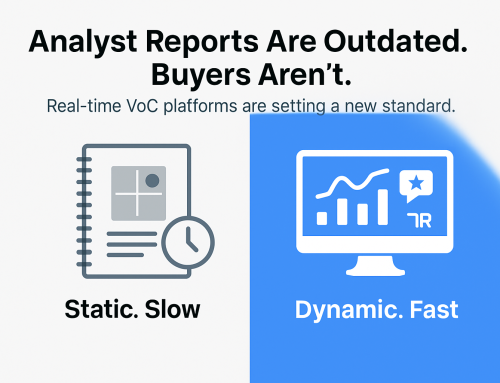Smart start-ups have discovered a fast track into coveted Gartner Magic Quadrant reports – leaving established enterprise players trailing. Across multiple markets, emerging vendors are leveraging a wave of peer reviews from customers to surf into leadership positions, writes Simon Jones.
On November 29 2018, I ran a webinar featuring Brandon Davis from Spredfast and KCG’s Bill Hopkins, to look at how Gartner’s bold statement is coming true: “Vendors that source reviews from every single client and commit to innovating will win.”
With Gartner Peer Insights adding almost 10,000 reviews per month, it is steadily closing the gap in terms of numbers on leaders G2 and TrustRadius.
In fact, Gartner is already claiming its 130,000 review total earns the crown for the largest number of reviews from enterprise customers, because other review platforms focus more on SMBs.
With this in mind, we asked: Is it possible to still be a leader without supporting customer reviews?
Laying down the peer review gauntlet
The gauntlet has been laid down – but to date, large enterprises have been slow to pick up on this new trend. With all three of the leading sites continuing to rack up reviews, the sheer volume is starting to impact on flagship reviews like Gartner Magic Quadrants. We predict it won’t be long before peer reviews overtake the traditional process of providing carefully-cultivated reference customers for analyst evaluation reports.
For AR professionals, missing the boat in managing peer review sites could also mean surrendering control of major evaluations.
It’s time for enterprise vendors – in particular – to double down on customer reviews on peer reviews sites. These also mean fast-track access to insights and content – faster and cheaper than traditional AR approaches. If you’d like to access a recording of the webinar, get in touch.
I then handed over to Brandon, who is Senior Manager, Analyst and Influencer Relations at Spredfast, to share his experiences in racking up peer reviews – and to outline some of the reasons why.
The implementation of a comprehensive customer review program has become a strategic tool for enterprise vendors to increase their profile, writes Brandon Davis. For less than the cost of a Magic Quadrant reprint license, it’s now possible to stand-up a review program, generate real-time customer content and contribute greater business value across an organization.
Peer recommendations reign supreme
Today, we’ve reached the stage where peer recommendation reign supreme when considering software investments.
There’s no shortage of evidence that enterprise buyers are taking reviews seriously in the buying journey. Both Gartner and Forrester are recognizing this trend. According to Gartner: “Enterprise customers are most likely to disqualify a provider due to peer opinions or confusing/contradictory information.” Forrester says enterprise buyers in North America are increasingly acting more like B2C consumers, adding that review sites like TrustRadius and G2 Crowd are “a required step before purchase”.
Programs can be implemented quickly and for minimal investment
In less than a year, Spredfast increased the total number of public reviews by 70 percent across all three major sites: TrustRadius, Gartner Peer Insights and G2Crowd. Following an initial focus on TrustRadius, Spredfast now leads its category by a healthy margin, outperforming key competitors across 90 percent of reviewed features. Now that Gartner has formally recognized our market on Peer Insights, we have begun building our presence.
Customer reviews have value across an organization
In stark contrast to analyst research, customer reviews can very quickly generate high volumes of relevant, real-time, customer-generated content. Major evaluations like MQs and Waves come around every one or two years. By contrast, peer review sites allow for the generation of new content several times per month. This is especially helpful in countering any unfavorable positions in major analyst reports. Further, the leading peer review sites feature research similar to analyst evaluations, providing further opportunities for vendors to move “up-and-to-the-right!”
In embracing peer review sites, best practice is to continuously promote reviews and ratings. In comparison to content generated by Spredfast, customer review content promotions have garnered a 35 percent higher engagement rate with target audiences (spoiler alert: we focus exclusively on enterprise buyers). As a result, strong review content can be used in various GTM materials and has enormous potential as a reservoir for case study and brand ambassador candidates.
Forward-thinking vendors are also using peer reviews to identify product development opportunities and promote feature and support launches. What’s more, they provide a clear window into the key challenges faced not only by customers but also competitors.
Pay attention or play catch-up
This is a special time, since many of the major vendors that lead major analyst evaluations are still falling short on customer validations.
For up-and-coming vendors, one tip in getting started is to look at any recent MQ or Wave then compare that to customer ratings on the various peer review sites. You’ll find that enterprise vendors consistently underperform their competitors, especially ones they deem non-competitive.
For enterprises, what more incentive do you need than to see tiny, “non-competitive” start-ups creaming you on review sites?
The ultimate prize an AR professional is to lead your respective category. Countless hours and significant investment go into this achievement, but with evolving buying habits, is it any longer possible to be a “Leader” without supporting customer reviews?





